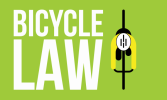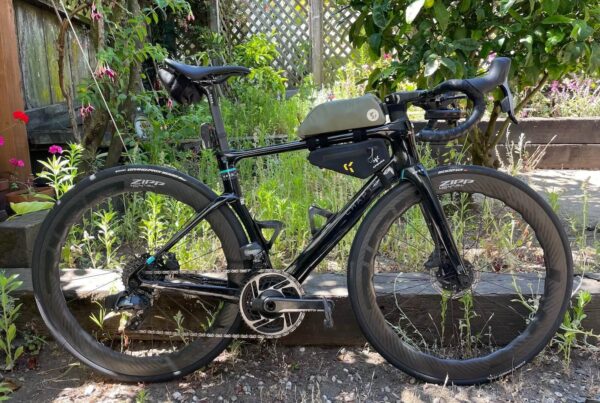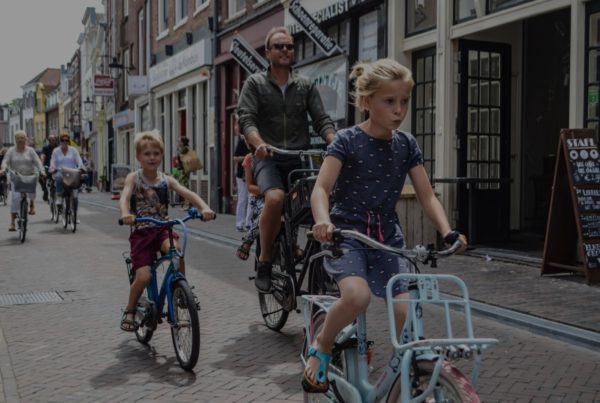By Rick Bernardi. J.D.
Can a bicyclist pass on the right?
This is a question that we’ve come across more than once, most recently in a crash that happened in California. As the cyclist explained,
I was doored by a passenger door in the right traffic lane on a busy California road. I typically ride to the far right of that lane about 2-3’ left of parked cars which I monitor very closely for doors opening or pedestrians walking quickly of the sidewalks to enter on driver side. When I approach a light, the right lane traffic starts to stop and I proceed up to the light. It was a surprise to have a passenger door flung open by the driver in this case in my path to allow a pedestrian to enter the car.
Doorings are a common type of car-on-bike collision, but as you will see, this one is a little different. In most jurisdictions, cyclists are required to ride as close to the right as is safe for the cyclist. So how close is safe? Because cyclists are at risk of getting doored while riding in the door zone, a reasonable interpretation of “as close to the right as is safe” would mean outside of the door zone.
At the same time, many bike lanes are placed directly in the door zone of cars parked along the curb. Many jurisdictions require cyclists to ride in a bike lane if one is available, but this requirement typically allows cyclists to leave the bike lane to avoid “hazards.” So what is a “hazard”? The law specifies some hazards, but doesn’t spell out every single hazard (that’s a good thing). But one example of a common “hazard” for cyclists is getting doored, so again, a reasonable interpretation of the law is that cyclists are not required to ride in the door zone.
But as I said, this case is a little different. The most common type of dooring occurs when a driver or passenger of a vehicle parked along the right curb opens a vehicle door directly into the path of a approaching cyclist. But that’s not what happened in this dooring. Instead, the cyclist was doored by a vehicle to his left. The cyclist was sharing the lane, riding as close to the right as he felt was safe, and was closely monitoring the parked cars to his right to avoid being doored. The vehicles to his left had come to a stop as they approached an intersection. Because he was sharing the lane, he filtered forward to the intersection. And then a driver in the traffic lane (to his left) suddenly flung open the passenger door of his vehicle to allow his son, who was stepping into traffic from the curb, to enter the vehicle while it was stopped in traffic. The cyclist, who had been filtering forward to the intersection, collided with the opened door and sustained non-life-threatening injuries.
The cyclist was transported to the hospital for treatment; while he was there, a police officer investigating the collision took the cyclist’s statement. But later, when he saw the police report, the cyclist was shocked. The investigating officer had reached the conclusion that the cyclist was at fault for passing on the right (the cyclist was not ticketed for a violation, however).
Now, remember, this article asks the question “Can a bicyclist pass on the right?” But there’s another question here: Can the driver open the passenger door into the path of a approaching cyclist? Under California Vehicle Code (“CVC”) Section 22517,
No person shall open the door of a vehicle on the side available to moving traffic unless it is reasonably safe to do so and can be done without interfering with the movement of such traffic…
Now, if the cyclist was operating legally, the motorist was in violation of this statute. But the investigating officer claims that the cyclist was breaking the law by passing on the right. So lets take a look at the officer’s argument to see if it is accurate.
Imagine a common scenario—a cyclist is sharing the lane with motor vehicles (or, alternatively, is riding in the bike lane). At times, the motor vehicles will be moving faster than the cyclist. But not always. Sometimes, the cyclist will be moving faster than the motorists. Now, according to the officer’s interpretation of the law, it is legal for the drivers to pass the cyclist when they are moving faster, but it is illegal for the cyclist to pass when he is moving faster. Before we even look at what the law says, ask yourself “Does this make sense?” According to the officer’s interpretation of the law, if traffic begins to back up, or even comes to a stop, the cyclist must also slow down, and even come to a stop, even though the lane is wide open for the cyclist. If the cyclist follows the officer’s interpretation of the law, the result is a roadway on which cyclists are required by law to always fall back, and never pull ahead, to stand patiently waiting in the wide open bike lane for traffic to his left to begin moving again so s/he can begin riding again.
This does not make sense—and it is not the law. Instead, the law lets drivers and cyclists do the sensible thing. When motor vehicle traffic is moving faster, drivers pass the cyclist. And when the cyclist is moving faster, the cyclist passes the drivers. The proof is in the law itself. Under CVC Section 21754
The driver of a vehicle may overtake and pass to the right of another vehicle only…upon a highway with unobstructed pavement of sufficient width for two or more lines of moving vehicles in the direction of travel…
Now, with that in mind, let’s consider what the law says about operating a bike on the road. Under CVC Section 21202:
Any person operating a bicycle upon a roadway at a speed less than the normal speed of traffic moving in the same direction at that time shall ride as close as practicable to the right-hand curb or edge of the roadway…
This section of the vehicle code expects that when cyclists ride to the right, they will be sharing the lane with motor vehicles. Alternatively, when a cyclist is riding in a bike lane, the cyclist has a separate lane. In either case, whether a cyclist is sharing a lane or has a separate lane, passing on the right is permitted under California law. The law isn’t just referring to two motor vehicles traveling side by side. It is referring to twovehicles—and in California, a cyclist has all of the rights and applicable responsibilities of a vehicle operator. Among other things, this means that when a cyclist is sharing the lane with a motorist (or, alternatively, riding in a bike lane), the law allows the cyclist to pass the motorist on the right when the cyclist is traveling at a faster speed.
In other words, the officer is wrong on two counts. First, the cyclist did not violate the law by passing to the right of the motor vehicles he was lawfully sharing the lane with. In fact, the cyclist was doing exactly what the law expects and allows. And second, the driver did violate the law, by opening his door into moving traffic. This should have been the conclusion of the police report, Instead, the police report reached the opposite conclusion—and the cyclist will likely have an uphill battle with the driver’s insurance company because the investigating officer got the law wrong.
For a cyclist, one of the immediate issues in the days following a crash would be to make sure the police report is accurate—and to take steps toamend the report if it is not accurate. For the rest of us, this incident highlights the continuing need for law enforcement officers who are adequately trained in and understand the law as it applies to bicycles. As bicycling becomes a more common part of everyday life on the roads, we are seeing progress in the education of law enforcement, but as this incident illustrates, we’re not there yet.




When traffic slows, a bicyclist has the options of:
* slowing or stopping so as not to pass
* passing on the left, which is the normal way
* passing on the right, which is permitted, as you note, but there is a special duty to make sure it’s safe (CVC 21755: “The driver of a vehicle may overtake and pass another vehicle upon the right only under conditions permitting that movement in safety.”)
Yes, no one should open a car door if it’s not safe (whether parked or not parked), but the person passing on the right also has a responsibility, because he or she is in an unexpected place. This often comes up in the case of motorist turning right: it’s clearly not safe when the vehicle ahead is signaling a right turn.
If there is a bike lane, the legal situation is different, because the law says that no one can move into the lane without first checking and yielding and everyone must merge into it before turning right (except in Oregon, of course). However, the practical and safety situation is NOT different for the bicyclist, and he or she would be wise to ride as if the bike lane did not exist. That is: keep a safe distance away from parked cars and avoid passing on the right except when traffic is completely stopped and can’t move and then only slowly and cautiously (keeping an eye out for pedestrians crossing between stopped cars and yes, opening doors on both sides).
It is not correct to say that a cyclist riding to the right is in an unexpected place. The law specifies that cyclists who are not riding at the speed of traffic must ride to the right. Conversely, the law allows, but does not require cyclists who are riding at the speed of traffic to take the lane. Therefore, a cyclist who is riding to the right is exactly where the law either expects or allows the cyclist to be, and it is incorrect to say that the cyclist who is following the law is in an unexpected place.
A driver may be ignorant of the law, or inattentive, but the driver’s failure doesn’t magically transfer to the person following the law just because s/he happens to be on a bike.
Finally, note that the cyclist was doing exactly what you advise: passing on the right when traffic was completely stopped.
You wrote: “The law specifies that cyclists who are not riding at the speed of traffic must ride to the right.” Not so: it says you must ride to the right when bicycling “at a speed less than the normal speed of traffic” [bicyclist was going FASTER than the stopped traffic] and it specifically gives an exception for “overtaking and passing another bicycle or vehicle proceeding in the same direction.”
I’m not saying the bicyclist is at fault here, legally. The passenger is at fault for opening the door when not safe.
However, the law does not give blanket permission to pass on the right. Certainly passing on the right of a car signaling a right turn is unsafe and would be negligent.
Regardless of the legal interpretation, if you want to avoid injury when bicycling, you have to pass on the right only slowly and cautiously, considering the multiple potential hazards.
Paul, your analysis has devolved to the ridiculous, as VC dogma so often tends to do.
There’s no need to nitpick over the exact language of the statute, we both know what it says. I’m pretty sure you got the gist of what I was saying. And it’s beyond ridiculous to say that the cyclist is traveling faster than the normal speed of traffic when that traffic is stopped at a red light. Yes, he was traveling faster than the cars were at that moment, but traveling faster than the normal speed of traffic? Seriously? Under that analysis, the cyclist would have to move to the right when traffic is moving, and merge to the left when traffic has stopped. More or less what the officer was saying, and equally ridiculous.
Really looking forward to the day when VC advocates stop looking for ways to blame law-abiding cyclists when drivers break the law.
Rick, enough with the name-calling. The bottom line is that you left out a key element of the law in your analysis: “The driver of a vehicle may overtake and pass another vehicle upon the right only under conditions permitting that movement in safety.”
Tell me, does this law apply or not apply to this situation: a bicyclist passing on the right of stopped traffic?
“Paul, your analysis has devolved to the ridiculous, as VC dogma so often tends to do.”
Nice way to engage a discussion.
When a discussion devolves into the ridiculous, it is fair to note that it is ridiculous.
You said: “Yes, he was traveling faster than the cars were at that moment, but traveling faster than the normal speed of traffic? Seriously?”
Yes, seriously: the law says “at a speed less than the normal speed of traffic moving in the same direction *at that time*”. It’s not a question of average speed over the block or over the mile, or maximum theoretical speed, but simply speed *at that time*.
You said: “Under that analysis, the cyclist would have to move to the right when traffic is moving, and merge to the left when traffic has stopped.”
Yes, the cyclist keeps to the right of the lane (IF traffic is moving faster, and IF the lane is wide enough for a car to pass without changing lanes), but if traffic slows, the cyclist has the 3 choices I listed in my first comment.
Paul,
As I read the law, it states “The driver of a vehicle may overtake and pass to the right of another vehicle only under the following conditions…”
And in this incident, the cyclist was proceeding in accordance with that section of the vehicle code.
Should a cyclist proceed to pass if it is unsafe– for example, in your hypothetical of a motorist signaling a right turn? Of course not. But that is not what happened here.
Nobody expects motorists traveling in the right lane to come to a stop just because the motorists in the left lane come to a stop. Nobody accuses them of “passing on the right.” Nobody invents hypothetical scenarios to suggest that the motorists in the right lane are operating in an unsafe or illegal manner. And yet, put a cyclist in the exact same situation, and everybody starts inventing imaginary reasons why the cyclist was in the wrong.
Rick, it may be that “the cyclist was proceeding in accordance with that section of the vehicle code” but not in accordance with the following section, which says you may only do it when safe. You can find it here: https://www.dmv.ca.gov/pubs/vctop/d11/vc21755.htm
The difference in your example with motorists is the lane line, which makes passing on the right safe because no one is allowed to move into another lane unless it is safe to do so. (This would be true also of a bicyclist passing on the right in a bike lane, IF motorists treated a bike lane as a lane, which they generally don’t.)
And again, I’m not saying the law makes the cyclist in this case clearly negligent. There’s a bit of a gray area. And I already said the person opening the door is negligent. But, to repeat, bicyclists passing on the right do so at their own risk and should use caution, specifically looking for peds crossing, doors opening, and right-turning cars. This means they must go more slowly than normal — often not much faster than a walk. And in many cases it’s better just to stop and wait (for example, a few cars back from a red light).
Do you disagree, or are you encouraging bicyclists to pass on the right at normal speed?
“Yes, seriously: the law says “at a speed less than the normal speed of traffic moving in the same direction *at that time*”. It’s not a question of average speed over the block or over the mile, or maximum theoretical speed, but simply speed *at that time*.”
Paul,
You are missing the forest for the trees here.
The law requires cyclists to ride to the right when they are traveling at “less than the normal speed of traffic moving in the same direction at that time.”
This cyclist was riding to the right. Traffic came to a stop. Does the law allow him to merge with traffic to his left? Yes. Does it require him to merge with traffic to the left? No. And in fact, a cyclist constantly merging left and moving to the right depending on whether traffic is slowing or accelerating is unnecessary, ridiculous and unsafe. At a minimum, this cyclist was exactly where he was allowed to be, when traffic was moving, where he may have been required to be. He was following the law, the driver was not. If he had been a driver in an adjacent lane, instead of a cyclist, nobody would doubt for a even moment who was in the wrong here, and nobody would suggest that he should have merged from his lane into the lane that had come to a stop.
“it may be that “the cyclist was proceeding in accordance with that section of the vehicle code” but not in accordance with the following section, which says you may only do it when safe. You can find it here: https://www.dmv.ca.gov/pubs/vctop/d11/vc21755.htm%22
And what does subsection b say?
Here, I’ll save both of us the trouble: “This section does not prohibit the use of a bicycle in a bicycle lane or on a shoulder.” In other words, riding a bike on the right side of the road is not a violation of the “passing on the right” law.
“The difference in your example with motorists is the lane line, which makes passing on the right safe because no one is allowed to move into another lane unless it is safe to do so. (This would be true also of a bicyclist passing on the right in a bike lane, IF motorists treated a bike lane as a lane, which they generally don’t.)”
A, it’s true regardless of whether drivers are safe or not. B, nobody is allowed to move right and violate a cyclist’s right of way.
“Do you disagree, or are you encouraging bicyclists to pass on the right at normal speed?”
It depends. It may or may not be safe to travel at normal speed while riding on the right, depending on conditions. I do disagree that cyclists should stop when traffic to their left stops. I do agree that conditions may call for proceeding with caution.
Know your rights, practice awareness.
and….this is a good site to start out with
https://massbike.org/resourcesnew/bike-law/state-bike-laws/
The original account says, “When I approach a light, the right lane traffic starts to stop and I proceed up to the light.” In the context it is clear that “I proceed up to the light” means “I was passing slower traffic on the right within the same marked travel lane.” The CVC makes it clear that this IS permitted, but, unlike when passing on the left, there is an extra duty to make sure you can pass safely.
The same CVC rule also says you may not leave the roadway in order to pass on the right. Yes, there is a (recently added) section that clarifies that bicyclists may pass on the right using a shoulder or bike lane. This section is useful because a shoulder is not part of the roadway, legally, so technically previously it was not legal to pass on the right using a shoulder (but a bike lane is part of the roadway, so that was always OK). However, in this case there is no bike lane or shoulder, and the law is clear that bicyclists passing on the right may do so only “under conditions permitting that movement in safety.”
You say it is ridiculous, absurd, dangerous, etc. for the cyclist to “constantly merge left and right.” But this is completely your own construction (some would call it a Straw Man). As I have said, the cyclist in this case had a clear alternative: wait behind stopped traffic until the light changes. That’s why they were stopped. The cyclist has to wait for the light to change anyhow, right? There is also the alternative of passing on the right (so as not to get stuck behind multiple light cycles, or if you want to make a right turn on red). This is legal, but is only safe when done slowly and carefully.
Finally, you assert “If he had been a driver in an adjacent lane, instead of a cyclist, nobody would doubt for a even moment who was in the wrong here, and nobody would suggest that he should have merged from his lane into the lane that had come to a stop.” But the cyclist is not separated from other traffic by a lane line and does NOT need to merge “from his lane.” The absence of a marked lane line changes the legal (and safety) situation completely, so your comparison fails.
The problem is that by definition, a lane is a strip of road intended for a single line of vehicles, but by CVC 21202 a bicyclist is expected to create a second line at the right edge of a lane. That creates the confusion where the law requires bicyclists to create a second line within a lane, but if the lane is not wide enough for a car to pass on the right (such as leading up to a right turn), then motorists don’t expect anyone to pass them on the right. A bicyclist may have the right to pass on the right, but motorists don’t expect a second vehicle to pass them within the lane.
The vehicle code requires that a vehicle be driven entirely within one lane, but I cannot find a section that prohibits two vehicles to be driven within one lane, even though on a freeway you’re expected to change lanes to pass. Straddle passing is just not done except while passing bicyclists. That’s just one of many ways that bicyclists are not treated as the drivers they are supposed to be by CVC 21200.
As a fast riding VC cyclist (though not a fanatic about all things Vehicular Cycling), I sometime pass slow traffic in the left lane, common on the 4 lane urban roads I ride. I can ride there because traffic is slowed or stopped in the right lane, so I pass them (legally) in the left lane. This does not apply to “filtering up” at stoplights, but on reasonably long reaches of multi-lane road. Your mileage may vary.
This is an interesting discussion on the increasingly less rare instance of passing slower cars, Hope my comment expands it a little. And just keeping my own score – Paul seems to be correct here and Rick seems to be kinda mean with the VC comment. Mellow out Rick – we’re all riding!